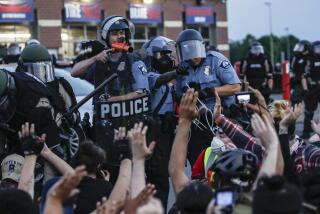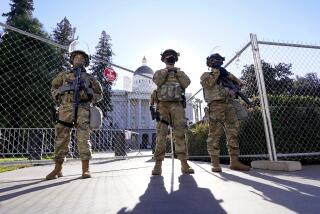Report Tracks Air Marshals’ Growing Pains
- Share via
WASHINGTON — Federal air marshals have encountered more than 400 suspicious persons and were involved in 28 arrests -- none for terrorism -- since the Sept. 11, 2001, terrorist attacks, according to a government report to be released today.
The report by the congressional General Accounting Office is the most extensive publicly available account of a secretive organization that grew from a little more than 30 marshals and a $4.4-million budget before the terrorist attacks to “several thousand” marshals and a budget of $545 million. The exact number of marshals is classified.
For travelers who have made a surreptitious pastime of trying to identify marshals on their flights, the report confirmed some stereotypes. Ninety-six percent of the marshals are men, 73% are white and 72% are between the ages of 31 to 45. A copy of the 41-page report was obtained by The Times.
GAO investigators concluded that the Federal Air Marshals Service has largely resolved early problems related to training, scheduling and morale that arose as supervisors hurried to meet a deadline for deploying a fully functional organization by July 2002.
But the congressional investigators recommended that the service improve its system for tracking the hours worked by marshals, for whom fatigue is a leading job-related problem. And the GAO also recommended that a recent decision to move the marshals to U.S. Immigration and Customs Enforcement be closely followed by Congress to ensure the relocation does not undermine the program.
“The report put to rest a lot of my concerns, but I’m not quite comfortable,” said Rep. Diane Watson (D-Los Angeles), who requested the GAO investigation as a member of the Government Reform Committee. “We’re going to continue to monitor this program. I want to make sure the marshals continue to provide safety for the flying public.”
While encounters with 444 suspicious persons on airliners between Sept. 15, 2001, and Sept. 16, 2003, may sound alarming, that number is very small in the context of 35,000 airline flights and an estimated 1.8 million passenger trips a day.
“A suspicious person can be someone who acts nervous,” said Gerald Dillingham, director of civil aviation issues at the GAO. “These were not 400 potential terrorists. They were people who, for whatever reason, struck a marshal as suspicious.”
A spokesman for the marshals said the agents are instructed not to single out passengers on the basis of ethnicity, such as Middle Eastern appearance. “We’re not picking out any groups,” David Adams said. “It’s behavior, the passenger’s actions.” Of the 28 arrests, most were of unruly or abusive passengers.
Training and unpredictable schedules were top concerns for rank-and-file marshals, and the report concluded managers have taken steps to address both.
To deploy thousands of marshals by a July 2002 deadline, the service reworked and shortened what had been a 14-week training course. Marshals hired from other law enforcement agencies received about a week of training, while those who had no prior police experience were given five weeks. Agents were no longer required to pass an advanced marksmanship course tailored for air marshals.
However, they were required to get a score of 255 out of a possible 300 on a standard federal law enforcement pistol-shooting test.
That score represents the highest accuracy level in federal law enforcement, according to the marshals service. “They are in a closed environment when they are up there at 30,000 feet. Shooting has to be precise and accurate,” Adams said.
An early decision to cut back on training in airline operations backfired, as air marshals became involved in frequent misunderstandings with airline employees, the GAO found. Improved communication with the industry has resolved much of the problem.
All marshals are getting more intensive training on a variety of issues, such as how the airlines work and marksmanship, the report said. The advanced air marshal marksmanship course is again being used, but as a training aid, not a requirement.
The attrition rate among marshals was about 10% during the two-year period, the report found, which compares favorably with other agencies. “It is well within reason, especially when you take into account this is a new organization,” Dillingham said.
Marshals work five consecutive 10-hour days, and scheduling became a major quality-of-life concern for those who signed on after Sept. 11. The previous program had been small enough that scheduling could be handled on paper. A computerized system was developed to better coordinate schedules, so that some marshals would not get too much work and others too little.
“There were indeed some bumps in the road,” Dillingham said. “There were concerns about morale and concerns about training, but not to the extent of jeopardizing the program.”
Problems flared up over dress codes. Dillingham said several of the 21 local marshals’ offices required a suit and tie, which some agents felt would give them away. A national dress policy allows for more individual discretion, requiring that marshals present a professional image and blend into their environment. “A marshal might wear a business suit on a morning flight to New York and a sports shirt on an afternoon flight to Orlando,” the report said.
Despite efforts to blend in, the GAO found 113 cases of marshals whose cover was blown, an almost weekly occurrence during the two-year period. In some cases, airline employees blurted out that there was a marshal on board, said Dillingham. In others, passengers correctly identified the undercover officers, and went up to them and thanked them for flying.
Hiring more women and minorities might alleviate that problem. “They could probably profit from trying to diversify,” Dillingham said.
More to Read
Sign up for Essential California
The most important California stories and recommendations in your inbox every morning.
You may occasionally receive promotional content from the Los Angeles Times.










